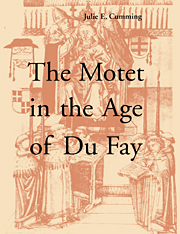Book contents
- Frontmatter
- Contents
- List of tables
- List of musical examples
- Acknowledgments
- Notes to the reader
- Introduction
- Part I Models and methods
- Part II Motets in the early fifteenth century: the case of Bologna Q15
- Part III Motets in the mid-fifteenth century: the case of the Trent Codices
- 8 Motets in the Trent Codices: establishing the boundaries
- 9 English and continental cantilena-style motets
- 10 Motets with a tenor cantus firmus c. 1430–1450
- 11 Freely composed four-voice writing in transition
- 12 The four-voice motet c. 1450–1475
- Conclusion
- Appendix: Widely disseminated motets
- Notes
- Bibliography of books and articles
- Modern editions of music
- Sources and sigla
- Notes on the index of works
- Abbreviations for subgenre identifications
- Index of works
- General index
8 - Motets in the Trent Codices: establishing the boundaries
Published online by Cambridge University Press: 22 September 2009
- Frontmatter
- Contents
- List of tables
- List of musical examples
- Acknowledgments
- Notes to the reader
- Introduction
- Part I Models and methods
- Part II Motets in the early fifteenth century: the case of Bologna Q15
- Part III Motets in the mid-fifteenth century: the case of the Trent Codices
- 8 Motets in the Trent Codices: establishing the boundaries
- 9 English and continental cantilena-style motets
- 10 Motets with a tenor cantus firmus c. 1430–1450
- 11 Freely composed four-voice writing in transition
- 12 The four-voice motet c. 1450–1475
- Conclusion
- Appendix: Widely disseminated motets
- Notes
- Bibliography of books and articles
- Modern editions of music
- Sources and sigla
- Notes on the index of works
- Abbreviations for subgenre identifications
- Index of works
- General index
Summary
Bologna Q15's distinct motet section allowed us to examine the repertory of motets and sort the pieces into subgenres without having to worry too much about which pieces were motets. Having established the subgenres in Q15 it was then relatively easy to identify the motets in other contemporary manuscripts. Unfortunately, there is no comparable source for the mid-fifteenth century. While the last source in Table 7.1, Modena X.1.11 (c. 1448), has a distinct motet section, its continental subsection contains only eighteen motets, and it is a little too early for the new developments of the third quarter of the century. Sources for all genres are scarce during this period, and it is particularly hard to find manuscripts containing substantial numbers of motets.
The principal surviving manuscripts from mid-century for all genres are the Trent Codices, a group of seven manuscripts copied between c. 1430 and c. 1475 and now found in Trent, Italy. Fortunately, the Trent Codices contain more than 1800 compositions (counting Mass movements individually), an international repertory whose origins extend from England to Eastern Europe, from Holland to Naples, in a heterogeneous mix of genres and styles. While largely neglected for much of the twentieth century, the codices have received considerable scholarly attention in recent years.
- Type
- Chapter
- Information
- The Motet in the Age of Du Fay , pp. 167 - 184Publisher: Cambridge University PressPrint publication year: 1999



